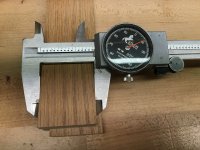promark747
Member
- Joined
- Jan 9, 2010
- Messages
- 501
I've removed the carpet and am ready to begin the process of cutting the 3.25-inch oak hardwood boards for placement over the wood substrate. My question is whether it makes more sense to install each course/row of tread boards one at a time and fit/scribe them to the sides as I go, or to arrange the loose boards on my MFT and then use my stair tread tool to transfer the exact dimensions and then cut, in place, with my TS55. Then I would carry the cut section as a whole over to the stair to be nailed and glued. I'm thinking that would give me cleaner lines on the sides.


